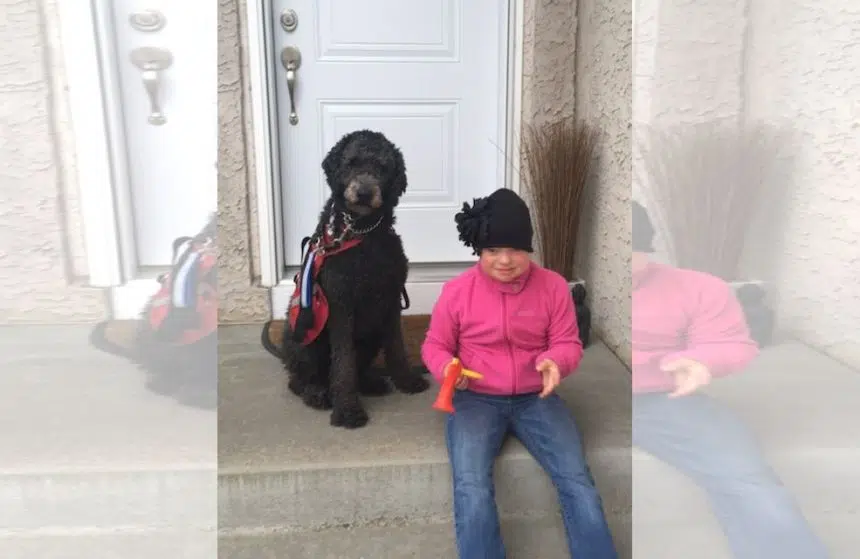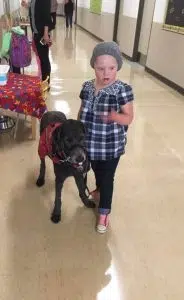A poodle completely changed what life looks like for one Warman family.
When Sheri Zwack was pregnant with her daughter Olivia, ultrasounds didn’t show Olivia’s heart condition or Down syndrome. She wasn’t diagnosed with autism until later.
“Autism is the one that is the biggest struggle with us, I think, because connecting to the world is a hard thing for her,” Zwack reflected.
“She can’t talk, she kind of says words here or there but it’s random stuff that doesn’t make sense. She’s not potty-trained, she needs one-to-one (help), like she was bolting,” Zwack said.
Zwack said it’s common for children with autism to struggle with safety, to have the urge to run away and to be attracted to water. The family has extra locks and deadbolts on many of their doors, out of Olivia’s reach.
Zwack remembered one day when Olivia ran away from daycare. That day, Zwack got a call from the RCMP that Olivia had been found at a manmade lake.
“That was hard,” Zwack said, tearing up.
When police located the girl, she hadn’t been able to answer their questions or tell them who she was.
“How does she tell someone (her name)?” Zwack wondered.
A friend of Zwack’s was fortunately part of the search team that found Olivia that day and recognized her. But it made Zwack fear for what could happen.
That led the Zwacks to get Ivan, Olivia’s service dog. He’s tethered to her most of the time and works to calm Olivia in various situations.
George Leonard, head trainer and a certified master dog trainer for MSAR Service Dogs in Winnipeg, said getting a service dog can make all the difference with a child who has autism.
It can mean significant peace of mind for parents whose children bolt, especially.
“Once the dog bonds with the child, the kid doesn’t want to go anywhere, because he’s got his dog. He really doesn’t run,” Leonard said.
Leonard said MSAR is one of the few organizations that trains any type of service dog, from those that help with PTSD to Down syndrome and autism, to mobility concerns.
For a girl like Olivia, who has both Down syndrome and autism, introducing Ivan to their family meant her mother could finally take a small step back.
“The mother is not the (service dog),” Leonard agreed, adding families he has spoken to have felt this freedom come with getting a service dog themselves. “It has changed their life.”
A service dog for anyone can mean more independence, but with kids who have autism, Leonard has seen children become more outward and go to school with confidence.
“It’s night and day, just the confidence in the child,” Leonard said of a family he met with recently. “They’re moving forward, they want to go do things, they’re proud to be with their dog, they’re happy to be with their dog.”
Finding the right fit
The first thing to do if considering a service dog is to consult with a medical professional, Leonard said. Only they can provide the diagnosis that someone would benefit from a medical apparatus — also known as a service dog.
“Once you get that, I would then try to talk you out of it,” Leonard stated.
The commitment to a service dog is significant and one that will change a life. Leonard will often interview families to find out what treatments and alternatives they’ve tried in the past and where they are in terms of development.
Leonard said it isn’t a process to rush.
“It’s a huge commitment financially and time-wise, so you want to make sure there’s other things you’ve tried before you go and get a dog,” he explained.
It also isn’t a fail-safe solution for every family.
“If you’ve met one autistic child, you’ve met one — because they’re all different,” he said.
If Leonard and the family agree to move forward with the process to get a service dog, he’ll then interview the family to better understand their needs and how a dog could be trained to help.
A dog will start its training around eight to 10 weeks old, spending the first few months running around outside and getting socialized. Training them begins with public access until around nine months, when trainers will start conditioning them to tasks to determine if a dog is doing what they hope it will.
Leonard said he’ll often see tendencies in a pup that might indicate they’d be good at one form of therapy over another — a strong anchor dog with “impeccable balance in public,” for instance, would make for good autism support.
For this reason, dogs are tailored to a family but specific puppies won’t be designated until their training shows they’ll be successful in the needed specialties. Leonard explained there’s about a 60 per cent pass rate for autism dogs.
When the dog is a year old, they’ll be introduced to their future family. They work with the family and trainer until they’re around two years old before they become completely certified with their person to support them full-time.
Leonard said he has only had to rehome a dog a handful of times in his career as a trainer. When a service dog hasn’t worked with a family, it usually has to do with the family not being supportive of the dog or their child not engaging with the animal.
The other concern would be children who have severe violent tendencies.
“If the child is violent and reactive, it’s going to be pretty hard for a dog to bond with that,” Leonard said.
“We are dogs”
Leonard said he has trained every form of support dog, from pioneering PTSD service dogs to autism and mobility dogs.
A dog who helps people with mobility would learn tasks like opening doors, picking things up and how to get things off of shelves or out of fridges.
“That all sounds cool until you’re training it and your dog’s in the fridge just helping himself to all the food, but that does happen,” Leonard said with a laugh.
The hope is that a service dog improves a person’s quality of life and their independence.
During his previous work as a dog trainer for police in Manitoba, Leonard worked on the Missing and Murdered Indigenous Women and Girls file, helping search for people. When they searched, often only members of the military would come and help.
After Sept. 11, 2001, while working with veterans from Bosnia, Leonard noticed a problem with their readjusting back to society, especially as many battled PTSD. He met with elders like Elijah Harper to discuss how they could expand their service dog program to get veteran supports.
That led to the development of dogs to specifically support people with PTSD. It took time and many observations of more than 300 dogs trained and placed across Canada to decide on the skills needed to train the “perfect” dog.
“It really started with a bunch of Indians sitting around the table,” said Leonard, who is Indigenous.
Saskatchewan doesn’t have its own service dog training school in the province because it’s considered a smaller province, like Nova Scotia or New Brunswick. That doesn’t mean the demand for service dogs isn’t there and it hasn’t reduced access, according to Leonard, who said there are trainers placed in Saskatchewan to help place dogs with families.
A PTSD dog generally will cost between $20,000 and $25,000, with dogs trained for mobility and autism supports more in the $30,000 price range. Often, families and organizations will fundraise to get a service dog.
The Zwacks were able to receive Ivan through the Lions Foundation Dog Guides in 2016 at no cost thanks to the organization’s fundraising efforts, despite his $25,000 price tag. He was born in Oakville, Ont., the province where Leonard said most Canadian dog trainers live.
“We love our Ivan. He’s so amazing and has captured the hearts of so many people,” Zwack said.
Daily life support
Support for children with autism, especially, is about anchoring them. Depending on the child, that can mean helping mitigate their risk of running away or helping them sleep. Leonard said service dogs can often help children learn to speak, as well.
“For long periods of time, they’re with the dog, and because there’s no judgment, they’re always talking to the dog. So they practise their words … and then they can start vocalizing,” he explained.
He has seen kids start to communicate verbally simply because they’ve been able to incessantly practise with their canine companion.
Dogs also help children with emotional regulation, de-escalating situations and breaking down barriers facing a child to help them navigate the world more easily. That can be as easy as giving another child something to talk to a child with special needs about — their dog.
Zwack said Olivia now has a lot of friends, but hasn’t always. Together, Zwack and Olivia used to speak to kids about inclusion and Olivia’s uniqueness, and offer ways for kids to connect with Olivia.
Zwack has heard some strange and mean things said about Olivia and how she looks. She laughed recalling how Olivia was once referred to as “the biggest baby” they’d ever seen. Zwack understood why they’d say this, what with Olivia’s young face and bald head.
“It totally changes your perspective on life. There’s so much meaningful things that she has changed personally for Jeff and I,” Zwack said, referring to her husband. “She has never done anything wrong to anyone and yet the world is fully against (her).”
When Olivia and Ivan became a team, her experiences at school improved.
“It was nice because he kind of pulled the kids in a bit,” Zwack said. “Everyone would say hello to her. Even my son, because he used to go to the same school, he was like, ‘Olivia’s like a little celebrity.'”
Ivan also helps with keeping a strict routine for Olivia. If she sees her dog’s bed moved or toys out of place, she will put them where they belong.
Saving lives
Zwack doesn’t know where they would be today if they hadn’t got Ivan.
“Before we got him, she didn’t sleep well, we’d go into, say, Home Depot and she’d flip out on the floor because (of) the lights … how do you control that?” Zwack said.
Sometimes, Olivia will get overwhelmed in public and have an outward reaction. Zwack is aware that others sometimes perceive Olivia as a bad kid, or her and her husband as bad parents. But Zwack wants people to understand that lights and sounds can be overwhelming for kids like Olivia — which is why Ivan’s presence is so helpful.
When a lot is happening, Olivia will sometimes cover her ears to try and shut out the noise. In those situations, Ivan will lay beside Olivia and lick her hand. The soft physical contact helps Olivia focus on Ivan instead of whatever is around her.
“There’s also that tactile response that they have,” Leonard explained. “Some autistic children, they love the feel of a golden or a Lab or a poodle and they like just standing there and patting the dog. It’s really soothing for them.”
On top of Olivia’s needs, Zwack is dealing with progressive spinal conditions that will likely put her in a wheelchair at some point. It makes it more scary for her to parent a child with extreme needs.
She said life can get overwhelming.
“As a parent, you’re just like, ‘How do I manage?’ … trying to manage her needs and my needs,” Zwack said.
Ivan has done a lot to help reduce that burden. Zwack knows as long as Ivan is with Olivia, there’s a set of watchful eyes on her daughter who can help if she becomes distressed in any way.
It feels “pretty good” for Leonard to know his work has tangible effects on the families he connects with.












